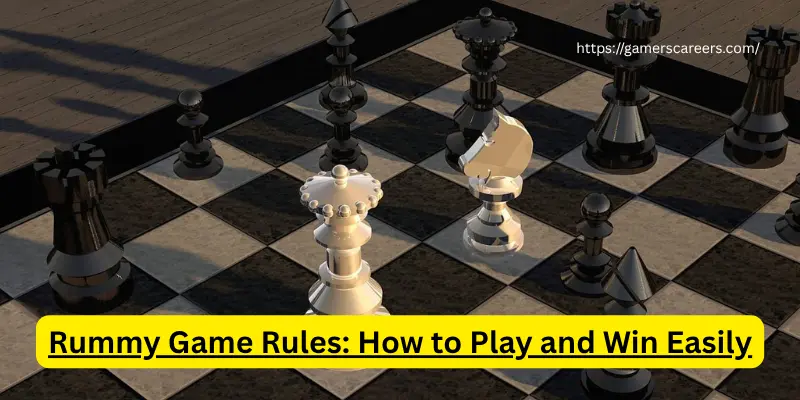Rummy Game Rules: How to Play and Win Easily
Published: 31 May 2025
Rummy is one of the most popular and entertaining card games played around the world. Known for its mix of strategy, skill, and a bit of luck, Rummy is easy to learn and fun for players of all ages.
In this guide, we’ll explain the basic rules of Rummy in a simple way. Whether you’re a complete beginner or just need a quick refresh, you’ll find everything you need to start playing and enjoying the game.
Objective of the Game
The main goal in Rummy is to arrange your cards into valid sets and sequences. To win, you must form at least one pure sequence and complete the rest of your cards into valid groups.
Key objectives:
- Form sequences: three or more consecutive cards of the same suit (e.g., 4♠, 5♠, 6♠)
- Create sets: three or four cards of the same rank but different suits (e.g., 7♣, 7♠, 7♦)
- Have at least one pure sequence without jokers
- Arrange all cards into valid sequences or sets
- Declare your hand successfully to win the game.

Number of Players and Cards Used
Rummy can be played with different numbers of players, but it’s best suited for 2 to 6 players. The game uses a standard deck of 52 cards, and sometimes jokers are included to add more fun and strategy.
Important details:
- Players: Usually 2 to 6 players can play
- Deck: Standard 52-card deck per game
- Jokers: One or two jokers may be included as wild cards
- Number of cards dealt: Each player gets 13 cards (in most versions)
- Remaining cards: Form the draw pile used during the game.
Basic Terminology
To play Rummy well, you need to understand some key terms. These words describe the important parts of the game and help you follow the rules easily.
Knowing these basics will make your game smoother and more fun.
- Meld: A group of cards placed on the table
- Set: Three or four cards of the same rank, different suits
- Sequence: Three or more consecutive cards of the same suit
- Pure Sequence: Sequence without any jokers (mandatory)
- Impure Sequence: Sequence that includes jokers
- Joker: Wild card that can replace any card
- Discard Pile: Where players put unwanted cards
- Draw Pile: Where players pick new cards from
Game Setup
Before you start playing Rummy, it’s important to set up the game correctly. This helps keep the game organized and fair for all players. First, shuffle the deck thoroughly to mix the cards well. Then, deal the right number of cards to each player—usually 13 cards if there are 2 to 4 players. If more people are playing, the number of cards dealt may change depending on your version of Rummy. After dealing, place the remaining cards face down in the center to form the draw pile. The top card from the draw pile is then flipped face up beside it to start the discard pile. Deciding who goes first is usually based on the player to the dealer’s left, but you can choose any way to pick the first player.
Steps to set up the game:
- Shuffle the deck well before dealing
- Deal 13 cards to each player (adjust if more players)
- Place the remaining cards face down as the draw pile
- Flip the top card of the draw pile to start the discard pile
- Decide the first player (usually dealer’s left)
- Make sure all players can see the discard pile
- Keep the draw pile accessible for players to pick cards during their turn.
How to Play Rummy
Playing Rummy involves taking turns drawing and discarding cards while trying to form valid sets and sequences. On your turn, you start by drawing a card either from the draw pile or the top of the discard pile. After adding the card to your hand, check if you can form or improve your melds. At the end of your turn, you must discard one card onto the discard pile. The goal is to organize your cards into valid sequences and sets and get rid of unnecessary cards. The game continues with players taking turns in clockwise order until someone declares a valid hand.
Basic steps during your turn:
- Draw one card from either the draw pile or discard pile
- Arrange your cards to form sets and sequences
- Discard one unwanted card onto the discard pile
- Watch other players’ moves carefully for strategy
- Try to remember which cards have been discarded and picked
- Declare your hand once all cards are in valid melds.
Rules for Valid Melds
In Rummy, not all groups of cards count as valid melds. To win, your cards must be arranged according to specific rules. The most important rule is that you need at least one pure sequence — a run of consecutive cards in the same suit without using jokers. Other cards can form impure sequences or sets, where jokers can be used as substitutes. Remember, all cards in your hand must be part of valid sequences or sets when you declare.
Key rules for valid melds:
- At least one pure sequence without jokers is mandatory
- Impure sequences can include jokers as wild cards
- A set is made up of cards of the same rank but different suits
- All cards must be arranged into valid sets or sequences before declaring
- You cannot declare if your hand doesn’t meet these conditions
- Jokers can’t be used in a pure sequence but are allowed in impure sequences and sets.
Scoring and Winning
The main goal in Rummy is to be the first player to declare a valid hand by arranging all cards into proper sets and sequences. Once a player declares, the game ends, and points are counted based on the cards left in other players’ hands. Cards have different point values, and the player with the lowest points wins. Understanding the scoring helps you plan your moves wisely to avoid high points.
How scoring works:
- Number cards (2 to 9) score their face value (e.g., 5 = 5 points)
- Face cards (J, Q, K) score 10 points each
- Aces score 10 points (or sometimes 1 point, depending on the variant)
- Jokers carry zero points
- The player who declares first scores zero points for leftover cards
- Other players add up points from cards not in valid sets or sequences
- The player with the lowest total score wins the round.
Declaring the Game
Once you’ve arranged all your cards into valid sets and sequences—including at least one pure sequence—you can declare your hand. But be careful! A wrong declaration can cost you the game. After declaring, you must lay your cards face-up on the table for verification. If everything checks out, you win the round, and scoring begins. If not, you get a penalty.
Things to remember when declaring:
- Make sure your hand includes one pure sequence
- All cards must form valid sets or sequences
- Discard your final card before declaring
- Place your hand face-up for others to check
- A wrong declaration may result in a maximum penalty.
Common Mistakes to Avoid
Even experienced players can slip up if they’re not careful. Knowing the common mistakes in Rummy can help you avoid penalties and improve your chances of winning. From forgetting the pure sequence to declaring too early, small errors can lead to big losses. Stay alert and always double-check your hand before declaring.
Mistakes to watch out for:
- Forgetting to include a pure sequence
- Using jokers in all sequences (not allowed for pure ones)
- Declaring with invalid combinations
- Discarding useful cards that opponents can use
- Not observing other players’ moves
- Declaring too soon without checking your hand properly
- Keeping high-point cards for too long.
Tips to Improve Your Rummy Game
Want to get better at Rummy? A few smart tips can help you become a more confident and strategic player. Rummy isn’t just about luck — it’s also about skill, memory, and decision-making. The more you play and pay attention, the stronger your game will become.
Helpful tips for better gameplay:
- Prioritize a pure sequence early in the game
- Discard high-point cards quickly if they’re not useful
- Watch what others pick and discard — it gives clues
- Use jokers wisely, especially to complete impure sequences
- Keep your hand flexible; don’t fix on one plan too early
- Practice regularly to improve your memory and card grouping
- Avoid rushing — take your time before discarding or declaring.
Conclusion
Rummy is a fun and skillful card game that anyone can enjoy once they understand the basic rules. From forming pure sequences to making smart moves with jokers, every step adds excitement to the game. Whether you’re playing casually with friends or joining a tournament, following the right rules and avoiding common mistakes can make all the difference.
What is a pure sequence in Rummy?
a) A sequence with jokers
b) A sequence without jokers
c) A set of same rank cards
How many cards are usually dealt to each player in a 2-4 player game?
a) 10
b) 13
c) 7
Which card can act as a wild card in Rummy?
a) Ace
b) Joker
c) King
What happens if you declare without a pure sequence?
a) You win automatically
b) You get a penalty
c) Nothing happens
From which piles can you draw cards during your turn?
a) Only the discard pile
b) Only the draw pile
c) Either the draw pile or discard pile

- Be Respectful
- Stay Relevant
- Stay Positive
- True Feedback
- Encourage Discussion
- Avoid Spamming
- No Fake News
- Don't Copy-Paste
- No Personal Attacks

- Be Respectful
- Stay Relevant
- Stay Positive
- True Feedback
- Encourage Discussion
- Avoid Spamming
- No Fake News
- Don't Copy-Paste
- No Personal Attacks





